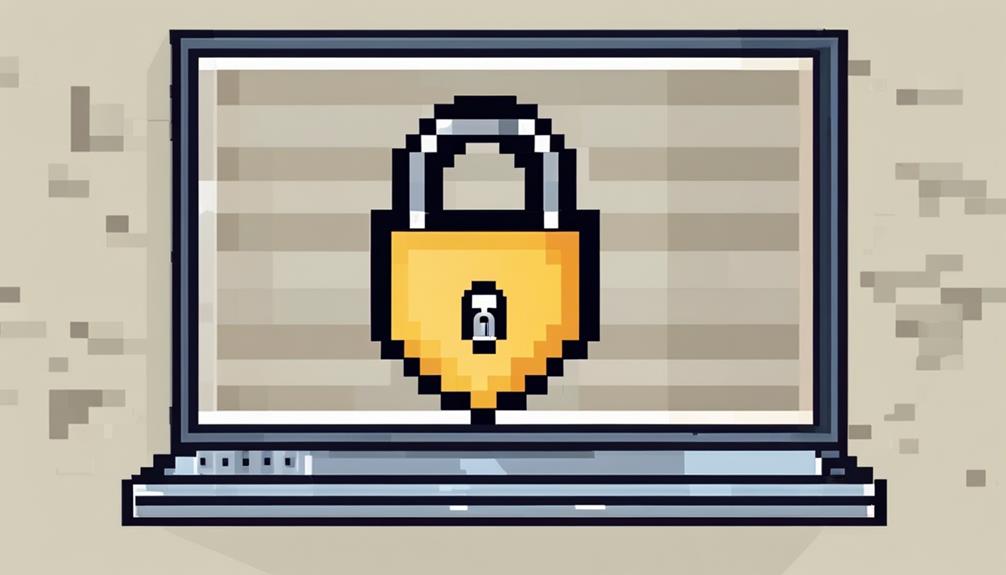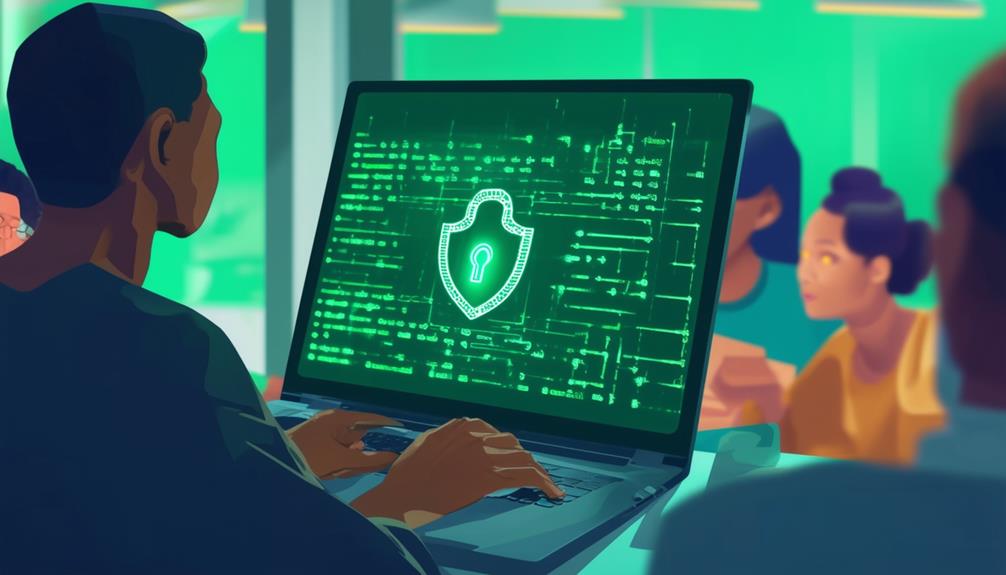To keep your computer safe from hackers, utilize robust antivirus software for malware protection and real-time scanning. Regularly update your system to patch security vulnerabilities and protect against cyber threats. Create strong passwords with a mix of characters and consider two-factor authentication. Implement firewall protection to block unauthorized access. Secure your Wi-Fi network with encryption and complex passwords, while monitoring for unusual activities. Increase awareness of phishing tactics to prevent falling for deceptive emails. These steps form a strong foundation for computer security. Additional expert tips can further enhance your defenses.
Key Takeaways
- Install antivirus software with real-time protection.
- Regularly update software for security patches.
- Use strong passwords and two-factor authentication.
- Employ firewall protection to block unauthorized access.
- Stay vigilant against phishing attempts with suspicious links.
Antivirus Software
How essential is antivirus software in safeguarding your computer from malicious online threats?
Antivirus software plays a vital role in protecting your computer from a variety of cyber threats like viruses, malware, and other harmful programs. By utilizing real-time protection features, antivirus software can detect and prevent malicious programs from infecting your system, ensuring your computer safety. Regularly updating your antivirus software is key to staying protected as it allows the software to detect and remove the latest threats effectively.
In addition to malware protection, antivirus software also scans files, emails, and websites for potential threats, enhancing your overall computer security. To further fortify your defenses, combining antivirus software with a firewall provides an all-encompassing layer of protection against hackers and cyber threats.
This all-encompassing approach to cybersecurity helps safeguard your personal information and sensitive data from falling into the wrong hands.
Regular Updates

Regularly updating your operating system, software, and applications is a critical practice to maintain the security of your computer and protect it from potential hacker threats. Security patches are often included in software updates to address known vulnerabilities that hackers exploit.
Hackers commonly target outdated software and systems with known security flaws, making regular updates essential for safeguarding your computer. By setting up automatic updates, you guarantee that your system receives the latest patches promptly, reducing the risk of cyber attacks.
Keeping your software updated strengthens your computer's defense against hackers and enhances its overall security posture. Failure to update regularly can leave your system vulnerable to various cyber threats, underscoring the importance of staying current with security patches.
Make a habit of checking for and installing updates to fortify your computer against potential security breaches and unauthorized access by malicious actors.
Strong Passwords

Ensuring strong passwords is an essential step in safeguarding your online accounts.
By creating complex passwords with a mix of characters, numbers, symbols, and uppercase letters, you enhance security.
Additionally, utilizing two-factor authentication and password managers can further fortify your defenses against potential breaches.
Password Complexity Importance
Employing strong passwords is vital for safeguarding your computer against potential hacking threats. Strong passwords, which consist of a combination of letters, numbers, and symbols, help deter hacking attempts by making it harder for cybercriminals to crack them.
It is important to use unique and complex passwords for each account to enhance password security. Avoiding easily guessable information like birthdays or names further strengthens password protection.
Regularly changing passwords is another effective practice to maintain password strength and protect against unauthorized access. Consider utilizing a password manager to securely store and manage your complex passwords, ensuring they are not easily forgotten or compromised.
Two-Factor Authentication Benefits
Implementing two-factor authentication provides an additional layer of security to protect sensitive accounts, complementing the strength of strong passwords. This security measure requires a second form of verification, such as SMS codes, authenticator apps like Google Authenticator, or biometric verification.
Even if passwords are compromised, two-factor authentication greatly reduces the risk of unauthorized access. Cybersecurity experts highly recommend using two-factor authentication to safeguard sensitive accounts from potential threats. By adding this extra barrier, it makes it more challenging for hackers to gain unauthorized entry into your accounts, enhancing overall security.
Utilizing two-factor authentication not only enhances protection but also offers peace of mind knowing that your accounts have an added layer of defense against cyber threats. It is a proactive step towards bolstering your online security and safeguarding your valuable information from potential breaches.
Password Manager Usage
Utilizing a password manager is essential for maintaining robust online security by generating and storing strong, unique passwords for each of your accounts. Password managers help you steer clear of easily guessable information like birthdays or names in your passwords. Strong passwords produced by password managers usually contain a mix of letters, numbers, and special characters, enhancing the security of your online accounts. These tools can also automatically input login information for websites, decreasing the risk of falling victim to phishing attacks orchestrated by hackers.
| Benefits of Password Manager Usage |
|---|
| Generates strong passwords |
| Stores unique passwords |
| Enhances security of accounts |
Firewall Protection

Firewall protection is essential in safeguarding your computer from cyber threats.
Understanding firewall configuration basics and the importance of regular updates are key to enhancing your security measures.
Firewall Configuration Basics
Enhancing your computer's security can be achieved through the proper configuration of its firewall protection. Firewalls prevent unauthorized access by acting as a barrier against intrusion attempts. Configuring a firewall is essential to block potential threats and enhance the security of your computer network. Both Windows and macOS include built-in firewalls that provide an initial layer of protection when enabled.
Consider investing in a hardware firewall or a business networking firewall for added security, especially for larger businesses. These hardware firewalls are specifically designed to alert you of intrusion attempts and prevent unauthorized access to your system. By configuring these firewalls correctly, you can significantly decrease the risk of cyber attacks and potential hardware failure.
| Firewalls | Benefits |
|---|---|
| Prevent unauthorized | Acts as a barrier against |
| access | intrusion attempts |
| Hardware and business | Additional security measures |
| firewalls | for larger businesses |
Importance of Updates
Regularly updating firewall protection is essential to maintain a strong defense against unauthorized access and potential security threats. Firewalls serve as a barrier against unauthorized access, with Windows and macOS offering built-in firewalls that should be enabled when connecting to the internet.
In addition to software firewalls, hardware firewalls provide additional layers of protection for your computer and network. For larger businesses, utilizing business networking firewalls is recommended to thwart intrusion attempts and prevent unauthorized access.
One of the key functions of firewalls is to alert you to intrusion attempts, helping to prevent hackers from gaining access to your system. By staying diligent with updates and ensuring your firewall protection is up to date, you can greatly enhance your computer's security and minimize the risk of falling victim to cyber threats.
Phishing Awareness

Awareness of phishing tactics is essential in safeguarding your personal information and protecting your computer from cyber threats.
Phishing, which accounts for 80% of reported security incidents, often involves hackers sending deceptive emails containing malicious links or attachments. These emails may appear to be from trusted entities, aiming to deceive users into revealing sensitive data.
To stay safe, always verify the sender's email address before clicking on any links in emails. Be cautious of urgent requests for personal information, as legitimate organizations usually do not ask for such details via email.
Secure Wi-Fi Networks

Effectively securing your Wi-Fi network is crucial in safeguarding your personal data and preventing unauthorized access by hackers. To guarantee the security of your Wi-Fi network, consider implementing the following measures:
| Measures | Description |
|---|---|
| Encryption | Use strong encryption protocols like WPA3 to protect your network from unauthorized access. |
| SSID | Hide your network's SSID and set up complex passwords to enhance the security of your Wi-Fi network. |
| Guest Network Access | Disable guest network access to reduce the risk of potential intrusions. |
| Monitor Network Traffic | Regularly monitor incoming and outgoing network traffic to detect any suspicious activities. |
| Secure Computer | Prevent unauthorized access to your network to protect your computer from potential hacker attacks. |
VPN Connections

Utilizing VPN connections enhances internet security by encrypting data and providing anonymity online. VPNs, or Virtual Private Networks, create a secure tunnel for your internet connection, safeguarding your data from potential hackers. By encrypting the information transmitted between your device and the internet, VPNs guarantee that sensitive data remains protected.
Moreover, VPNs offer anonymity by masking your IP address and location, making it harder for cybercriminals to track your online activities. This feature not only boosts privacy but also helps bypass geo-restrictions and censorship, allowing access to content that may be blocked in certain regions.
When connecting to public Wi-Fi networks, using a VPN adds an extra layer of security, reducing the risk of data interception.
It's essential to select reputable VPN providers to ensure secure browsing and maintain confidentiality while online. By incorporating VPN connections into your internet usage, you can greatly enhance your online safety and protect your sensitive information from potential threats.
Frequently Asked Questions
What Will Best Protect Your Computer From Hackers?
Implementing a multi-layered security approach is essential to best protect your computer from hackers. This includes strong firewall protection, regular software updates, complex passwords, email security vigilance, and utilizing antivirus software to detect and remove malware threats effectively.
What Protects the Computer System Against the Hacker?
Firewalls, antivirus software, strong passwords, regular updates, and network security are essential protections against hackers. With 95% of successful cyberattacks leveraging human error, these measures fortify the computer system against hacker intrusion and data breaches.
What Are 3 Ways You Can Ensure Your Safety if You Get Hacked?
In the event of a hacking incident, immediate actions include disconnecting from the internet, changing all passwords with two-factor authentication, contacting financial institutions, reporting to authorities, and seeking professional assistance to secure the system, along with implementing antivirus software and regular updates.
What Are 4 Ways You Can Protect Yourself From Getting Hacked?
Security breaches have increased by 11% in the past year. Protect yourself by enabling firewalls, updating antivirus software, using strong passwords, and being cautious of phishing emails. Backup your data regularly to prevent loss in case of a breach.
Conclusion
To guarantee, ultimately, substantially, implementing strong cybersecurity measures is essential to protect your computer from hackers. By utilizing antivirus software, keeping your system up to date, creating strong passwords, enabling firewall protection, being cautious of phishing attempts, securing your Wi-Fi network, and using VPN connections, you can greatly reduce the risk of a cyber attack.
Stay vigilant and proactive in safeguarding your digital information to safeguard the safety of your computer and personal data.









